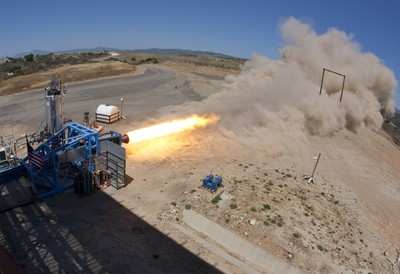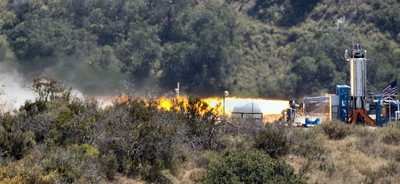Fri, May 29, 2009
Flight Tests Scheduled For Late '09
 In the desert of southern
California, Virgin Galactic’s key supplier, Scaled
Composites, and its subcontractor SNC (Sierra Nevada Corporation)
have successfully completed the first tests of the innovative
rocket motor that will propel space tourists, scientists and
payloads into space. The hybrid Nitrous Oxide system being used is
the largest of its kind in the world and it will send
Virgin’s customers up into sub-orbital space at speeds over
2500 mph, to heights over 65 miles above the Earth’s surface,
before the spaceship descends back down through the atmosphere
using its pioneering feathered re-entry system.
In the desert of southern
California, Virgin Galactic’s key supplier, Scaled
Composites, and its subcontractor SNC (Sierra Nevada Corporation)
have successfully completed the first tests of the innovative
rocket motor that will propel space tourists, scientists and
payloads into space. The hybrid Nitrous Oxide system being used is
the largest of its kind in the world and it will send
Virgin’s customers up into sub-orbital space at speeds over
2500 mph, to heights over 65 miles above the Earth’s surface,
before the spaceship descends back down through the atmosphere
using its pioneering feathered re-entry system.
Sir Richard Branson, founder of Virgin Galactic said: “As
Virgin Galactic gets ever closer to the start of commercial
operations, we are reaching and passing many important and historic
milestones. The Virgin MotherShip (VMS) Eve, the first of our
amazing, all carbon composite, high altitude WhiteKnightTwo launch
vehicles, is flying superbly. SpaceShipTwo, which will air launch
from Eve, is largely constructed and awaiting the start of its own
test flight program later this year.”
The rocket motor burns for a very short period of time because
the spaceship is launched from VMS Eve in the upper atmosphere,
rather than from ground level. This means much less fuel is
required, and the fuel burn is more environmentally benign than the
solid rockets used in most ground based systems.

While the rocket motor is extremely powerful, it is also completely
controllable. This system can - if necessary - be shut down at any
time, allowing the spaceship to glide back down to land at a
conventional runway. This is a significant feature in the overall
safety of the Virgin system for human space flight.

Sir Richard continues: “Less fuel and clean fuel all add
up to a space launch system which will be completely unprecedented
in its low environmental impact compared with current space flight.
The spaceship’s carbon footprint for each of its passengers
and crew will be about a quarter of that for a return trip from
London to New York."

The rocket motor will continue a series of exhaustive tests, and
the spaceship itself will start flight testing later this year.
More News
Aero Linx: Model Aeronautical Association of Australia MAAA clubs are about fun flying, camaraderie and community. For over 75 years, the MAAA has been Australia’s largest fl>[...]
Touchdown Zone Lighting Two rows of transverse light bars located symmetrically about the runway centerline normally at 100 foot intervals. The basic system extends 3,000 feet alon>[...]
“Discovery and innovation are central to our mission at Virgin Galactic. We’re excited to build on our successful record of facilitating scientific experiments in subor>[...]
How To Get A Story On Aero-TV News/Feature Programming How do I submit a story idea or lead to Aero-TV? If you would like to submit a story idea or lead, please contact Jim Campbel>[...]
Student Pilot Reported That During Rotation, “All Of A Sudden The Back Of The Plane Kicked To The Right..." Analysis: The student pilot reported that during rotation, “>[...]
 ANN's Daily Aero-Linx (05.02.24)
ANN's Daily Aero-Linx (05.02.24) ANN's Daily Aero-Term (05.02.24): Touchdown Zone Lighting
ANN's Daily Aero-Term (05.02.24): Touchdown Zone Lighting Aero-News: Quote of the Day (05.02.24)
Aero-News: Quote of the Day (05.02.24) ANN FAQ: Contributing To Aero-TV
ANN FAQ: Contributing To Aero-TV NTSB Final Report: Cirrus Design Corp SR20
NTSB Final Report: Cirrus Design Corp SR20






